Star Date: March 2019
Rajasthan
Hello Dear Family & Friends!
“Sub Kuch Milego.”
(Everything is possible – Hindi)

"Speaking the same language is not as powerful as speaking the language of the heart."
(Rumi)
Rajasthan. Palaces and medieval forts, maharajas with secrets, bedazzling jewels and exotic concubines hidden behind intricately carved walls. Tigers roaming the wilds with hunting parties looking for another trophy for the palace den. Camels forage for food in the barren desert as the hyenas howl. Inside the palace walls the opulence of court life is in sharp contrast to the austere life of the surrounding countryside. Serene gardens have overconfident peacocks vying for attention with the impressively dressed maharajas. Rajasthan is literally the ‘land of kings’, the land of rajputs.
Rajputs were warrior clans who claim to originate from the sun, moon and fire, and who have controlled Rajasthan for more than 1000 years. The chivalrous rajputs, were fiercely proud medieval kings whose past time was building magnificent forts and palaces. Opulence was only secondary to “Keeping up with the Rajas.” Competition saw many wars for power and spoils, all with great showmanship. Their sense of honor went unchallenged.
When no hope was left in battle, chivalry demanded jauhar (ritual mass suicide). Looking defeat in the face the men would don saffron robes and ride back onto the battlefield to sure death. Simultaneously the women and children inside the palaces were consumed by ceremonial fires.
The continual internal squabbling made the area weak and they were easily conquered by the invading Moguls. Divide and conquer. Their independent pride saw them released from the Mogul rule and form alliances with the British, which allowed them to maintain their titles and kingdoms. While the Rajas played polo, traveled the world in style, and lusted after the fineries of European life, buying endlessly and occupying whole floors of elite hotels; the poverty in Rajasthan grew.
Many of their palaces were turned into sumptuous hotels and museums, as the bags of gold were slowly spent by generations to follow. Indira Ghandi abolished what remained of these gluttonous kingdoms in the 1970’s. The families remain but unless they succeeded in business, wealth has eluded them and they live in the glory of their past; renting out parts of their palaces as B & B’s.
Powerful forts still loom from adjacent mountaintops, canons aimed at the invisible, formidable enemy below. Massive spiked doors that kept out war elephants have swung wide open revealing the fantasy world to those intrepid travelers who make it to the deserts of western India.
The maharajas encouraged the development of fine arts and to this day many designers seek their raw materials and inspiration from Rajasthan. The glory days of the Maharaja are past but in their wake remain colorfully dressed women in saris of every hue and shade. Bustling markets are laden with artisan’s wares and intricate handicrafts. Vibrant festivals, music and dance relive these days of glory at every chance. To travel the wilds of Rajasthan is to get caught up in a whirlwind of colors, tastes and sensations.
Udaipur is known as the City of Lakes. It was founded in 1558 by Maharana Udai Singh II of the Sisodia clan of Rajput, when he shifted his capital from the city of Chittorgarh to Udaipur; after Chittorgarh was besieged by Akbar. It remained as the capital city till 1818, when the British came on the scene.
Udaipur is known for its lavish royal residence. City Palace, overlooking Lake Pichola, is a monumental complex of 11 palaces, courtyards and gardens, famed for its intricate peacock mosaics. Fantastical palaces, temples, havelis (traditional, ornately decorated residences) and countless crooked, timeless streets make it easy to get lost in an intricate maze, unique to Rajasthan.
Booked into an ornate family Haveli on the lake we started our rather magical, regal look into the history and mystery of Rajasthan. We took a boat ride past the Taj Lake Palace, ($600 to $2,000 a night) home of the James Bond movie “Octopussy“. We continued on to explore the many palaces and temples adorning this fascinating city. I celebrated my birthday by buying a silk dress in the market with eclectic matching handmade leather shoes; later enjoying a regal candlelit dinner in a lakeside palace restaurant. Queen for a night I later ended up giving my dress, shoes and bright Indian ‘kurtas’ to a thrilled young girl in Jaipur.
Beckoned by the allure of Taj Lake Palace we heard of Lake Nahargarh Palace, built by a co-owner in nearby Parsoli. Off we went on a dusty, rowdy, noisy local Indian bus, the likes of which we had travelled on for over a year around India. We were thrown off in literally the middle of nowhere. We flagged down a truck and tried to explain that we had reservations at the Lake Nahargarh Palace. Astonishingly he proclaimed, “Oh you must have private transport to the private lake to catch a private boat over to the private palace in the middle of the private lake.” We explained that we were about ‘4 privates’ behind in the game and could he please give us a ride. After great bargaining we ended up at the edge of the lake. Our booking documents turned the key that opened the door to this private palatial fantasy world. Stepping off the boat was like stepping back into the era of the maharajas. Perfectly recreated, we wiped the dust off our bedraggled bodies and dove into the infinity pool; emerging born again Rajas. We enjoyed opulent, exotic surroundings and food for 3 days and two nights, compliments of the 85% discount on booking.com!
Continuing our regal tour we ended up in Bassi Fort Palace, recommended by our Italian friends we met in Sumatra. It was a glorious 450-year-old meringue of a place in Bassi village. This peacefully crumbling but intricately restored palace was full of antique furnishings including bedside lamps made from real, once used chain-maille helmets. The palace was closed for renovations but for some reason they gave us the deluxe suite which had recently been hand painted and decorated with loving care.
Because they were closed, it was quiet and we befriended the staff, like lovely turbaned Moha and the 19th generation Raj owner, Randeer. A classy older gentleman he let us look around the place. The family still lived in one private section. The enormous pool was waiting to be filled and the families’ centuries old fort loomed above. The large Bassi former kingdom included 45 villages. History oozed from every corner.
We were even driven into the World Heritage Chittingarh Fort by the Raj. Long lines were forming for entrance to the fort and miraculously the seas parted and we drove right through. Workers did all but bow to the Raj, the villagers former Maharaja of Bassi, as he explained that he had brought friends for the day and of course there would be no entrance fee! It’s all about who you know.
The back streets of the little village of Bassi had not changed in centuries. Our time spent exploring this puzzle of tangled alleys was a highlight of western Rajasthan. The people were warm and smiling and continually invited us into their basic but clean little houses for chai. We saw no other westerners in a week and thus we were treated with respect, humor and a bit of awe. Not a word of English spoken during that time, except by the Raj, we communicated with the language of the heart. And what a rich language that is!
And so it goes…………………………………..Next back to the quiet rice fields of Bali. Until then Keep Open and remember to speak to those around you in the language of the heart. We can all use a little kindness in our lives. We enjoy hearing from you. Take care!
Love, Light & Laughter,
xoxoox Nancy & Joseph
Travel notes:
$1.00US = 70.53 Indian Rupee
Udaipur:
Aashiya Haveli
17 Lal Ghat
# 91 294 2415015
Email [email protected]
Wonderful place. Quiet, small, clean. Helpful family – great location
Poonam Haveli = great rooftop restaurant
39 Lal ghat
Just up the hill on the left #91 294 2410303
Anju’s Ayurvedic products and massage – just up the hill on the right
4, Lal Ghat 91 94605 72377
Book ahead and bargain with Mrs Singh
Millets of Mewar- small cafe across foot bridge
Make sure to watch Octopussy before going to Udaipur
Bagore Ki Haveli
Good evening performance – Dharohar
7-8 PM dance and puppet show, ticket price Rs 60 + camera charges is absolutely worth and MUST to have a fun loving evening at Udaipur. Ensure you make it 15-20 minutes in advance to enjoy a front seating for close view and photography. The haveli may not look exciting but your mind won’t wander once the show kicks in.
Neel Kamal Restaurant at Taj Lake Palace is a must-visit at least once in your life. It gives you the feel of Udaipur all within the bounds of their beautifully decorated walls. Royalty and elegance radiate from Neel Kamal’s décor, with throne-like chairs, subtle colors reflected in the lily pond, and a hospitality team ready to take guests on an enchanting journey through the legend of Rajasthan. The live classical music playing in the background completes the fine atmosphere.
Address: Taj Lake palace, Udaipur, Rajasthan 313001, India, +91 294 242 8800
Restaurant Gateway just out side City Palace gates – up stairs on right
Upré by 1559 AD Restaurant
Upré by 1559 AD is a terrace restaurant with a wonderful view of the City Palace and Lake Palace. Located at the Lake Pichola Hotel, Upré by 1559 AD pampers their visitors with their great variety of local and international cuisines. The décor is elegant and stylish with light curtains that give their visitors their own solitary space. The ambience is tranquil and informal, creating a relaxing, peaceful atmosphere perfect for enjoying the breeze and the golden night sky glow.
Address: Lake Pichola Hotel, outside Chandpole, Near Hanuman Ghat, Udaipur, India, +91 294 243 1197
Bassi:
Hotel Bassi Fort Palace. 25 N. km chittaurgarh
The Chittor Fort or Chittorgarh is one of the largest forts in India. It is a UNESCO World Heritage Site. The fort was the capital of Mewar and is located in the present-day town of Chittor. It sprawls over a hill 180 m in height spread over an area of 280 ha above the plains of the valley drained by the Berach River. The fort precinct has several historical palaces, gates, temples and two prominent commemorative towers. Beginning in the 7th century, the fort was controlled by the Mewar Kingdom.
Bassi Fort Palace HERITAGE HOTEL
www.bassifortpalace.com ; s/d incl breakfast
Buses
to Bassi (13, 30 minutes) leave Chittorgarh’s
central bus stand about every half-hour.
Helper: Moha
Owner Randeer and 2 sons plus one brother living in the side palace
19th generation – Bassi former kingdom 45 villages
Hotel Raj Shree
Along highway at the end of the road from Bassi town
Great local food at a popular truck stop along the road to Chitogarh
Parsoli:
Lake Nahargarh Palace
Keep right to continue on NH27 Bus at 12:30 to Parsoli. Drop down at the road On the return we got a lift with the hotel in their van to Bassi. They were going to town for supplies.
Points Of Interest
Chhatris – 47.2 km
Chittorgarh Fort – 47.8 km
Fateh Prakash Palace – 48.8 km
Meera Temple – 48.9 km
Mahasati – 49.1 km
Tower of Victory – 49.2 km
Kalika Mata Temple – 50 km
Padmini’s Palace – 50.2 km
Badnore Fort – 59.3 km
After enjoying the luxury of Maharajan palaces (at great online discounts) I can say I don’t long for it permanently. One of the draws is that these palaces are set in beautiful quiet gardens or in the middle of lakes – providing a buffer from the interesting but chaotic streets of India. I prefer our little house in the rice fields of Ubud or our cabin along the shores of Lake Toba. And the same glorious moon shines on us all!
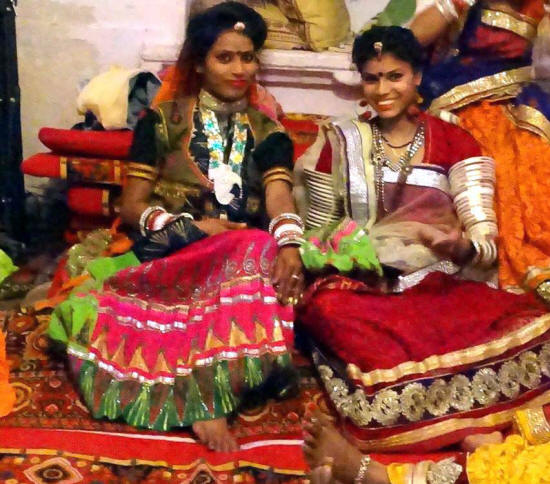
The colors of Rajasthan.

Behind palace walls.

Our Lake Nahargarh infinity pool.

The chef created a sumptuous Indian vegan
meal just for us.

Walking the palace roof by moonlight.

The narrow street leading to the palace.

Handiwork right outside our hotel in
Udaipur.
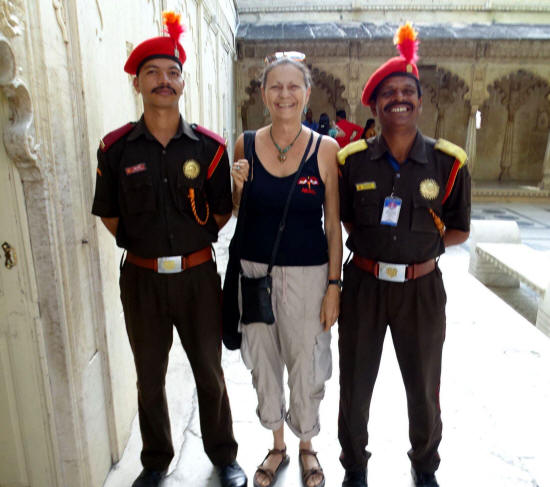
Smoozing with the Udaipur Palace
guards.

Stunning workmanship inside the City Palace.

Maharanas of Mewar are supposedly decedents
of the Sun god. This is a pure gold representation,
18 inches across, of their holiness.
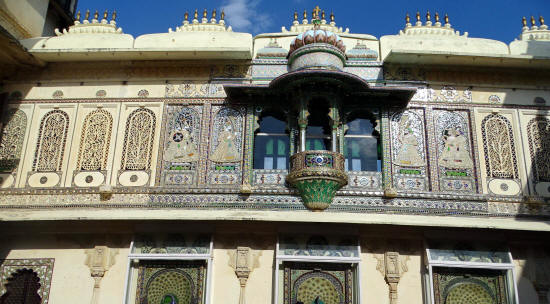
Intricate carvings inside and out.

The whole palace is a living work of art.
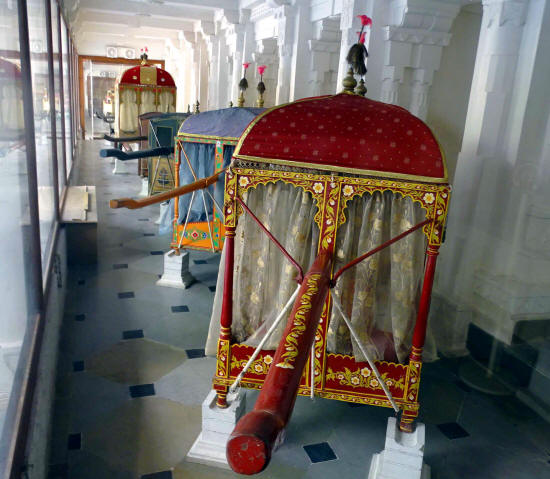
Taxi?
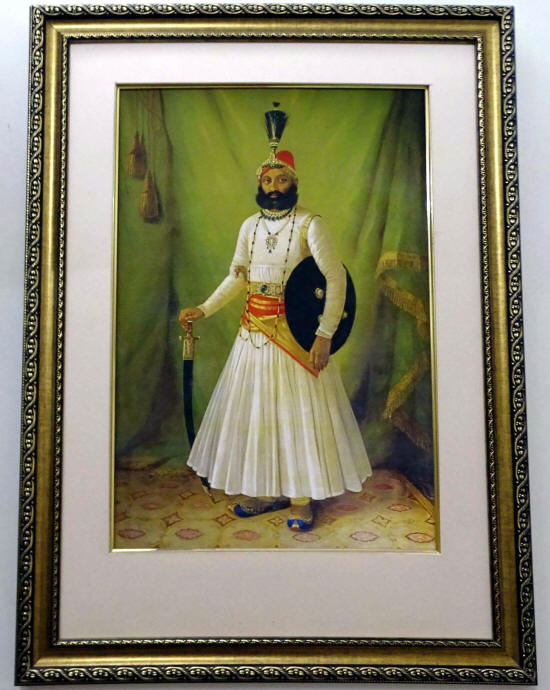
A Maharaja.
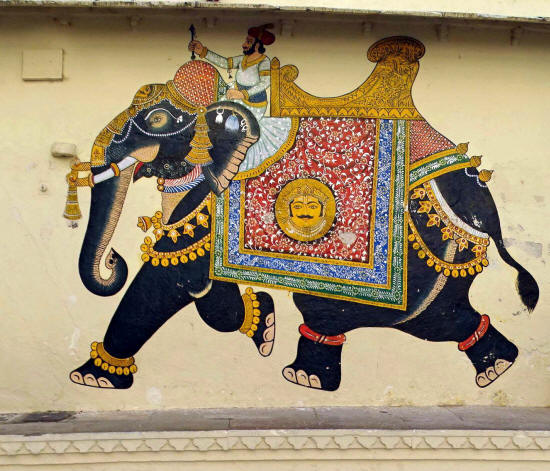
Riding the royal elephant.
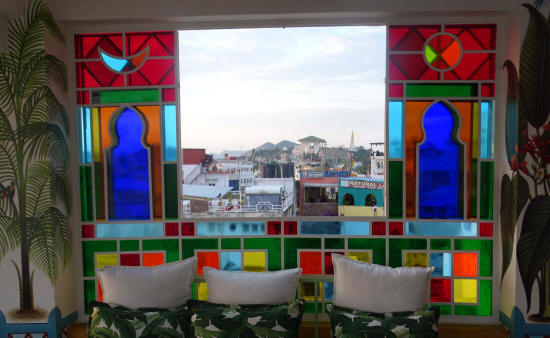
The view out our restaurant window.

As the sun set…

A Hindu ceremony attracted sari’s of all
colors.
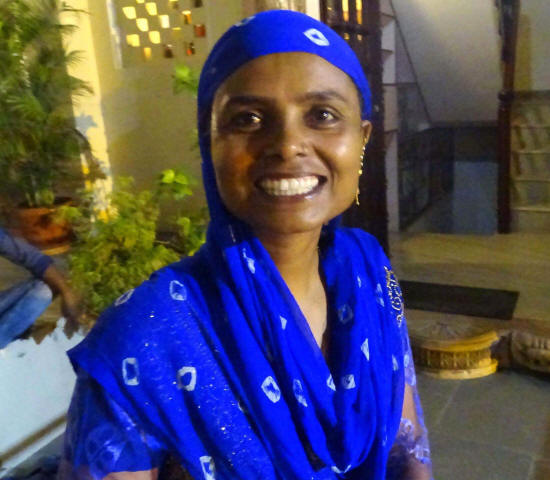
A radiant smile.

When night fell the streets were blocked
off and 3 story high, lighted Islamic images were
carried to the square in front of our hotel. Quite
a spectacular site.

Traditional veil dance.

This woman ended up with 6 ft. high
burning urns on her head, dancing all the
while.
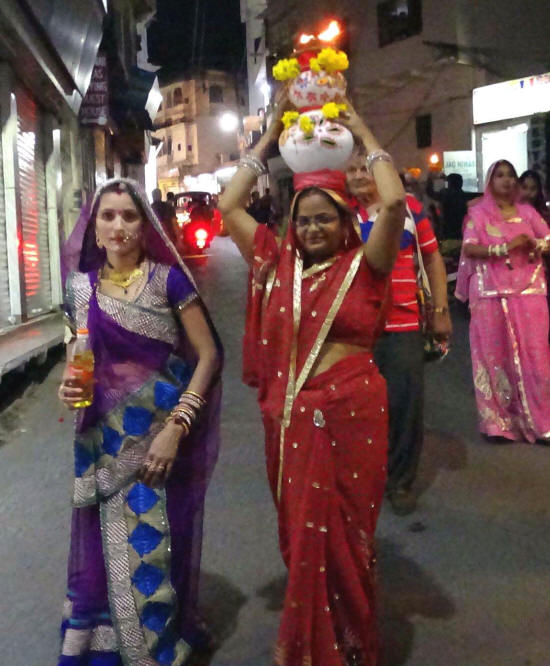
Hindu women off to the temple.
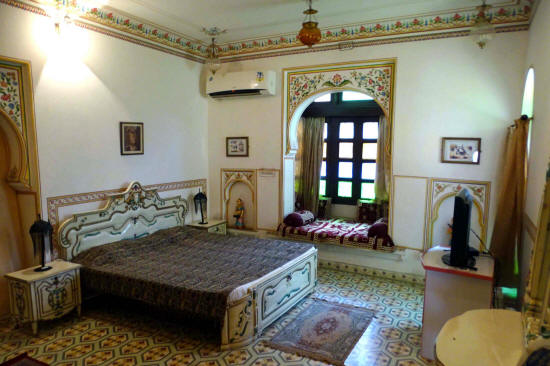
Hotel Bassi Fort Palace. Hard to see, but fine
intricately painted suite.

The men kept the beat.

Serene courtyard.
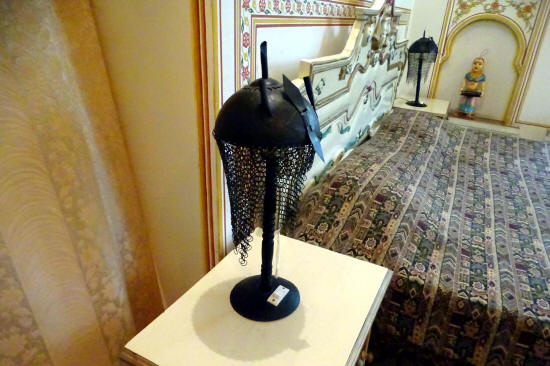
Authentic chain maille helmet, from
battles of old.

Another famous Raj.
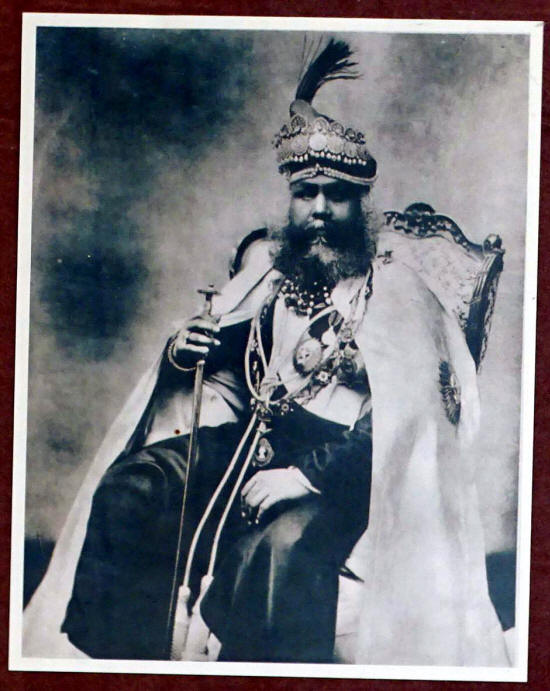
17th generation Raj, Randeer’s great
grandfather.

Everyday for a week we walked the
backstreets of Bassi.
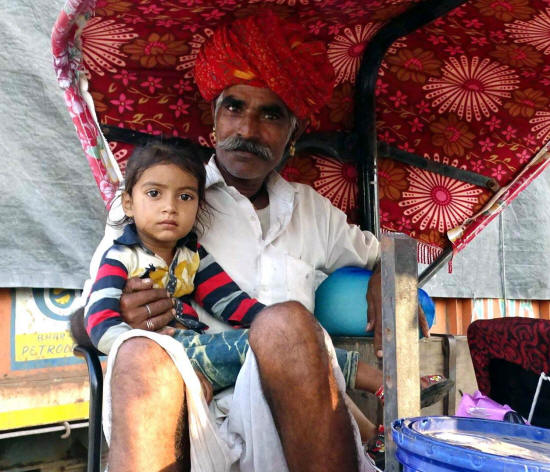
Proud Regal looking Grandpa.
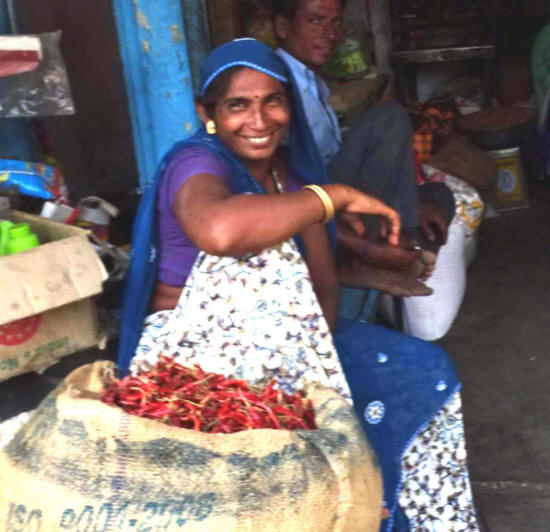
Beautiful shopkeeper.
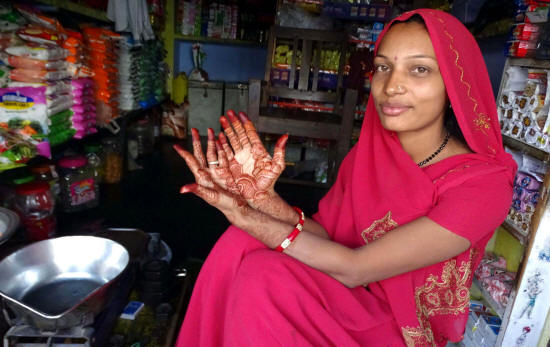
Henna designs grace the feet and hands of
Indian women, usually for special occasions.
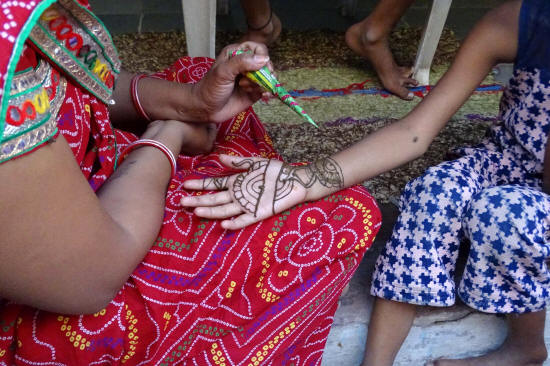
Henna application.

The back streets of the little village of Bassi had
not changed in centuries.

Group photo at the local temple.

Our time spent exploring this puzzle of tangled
alleys was a highlight of western Rajasthan
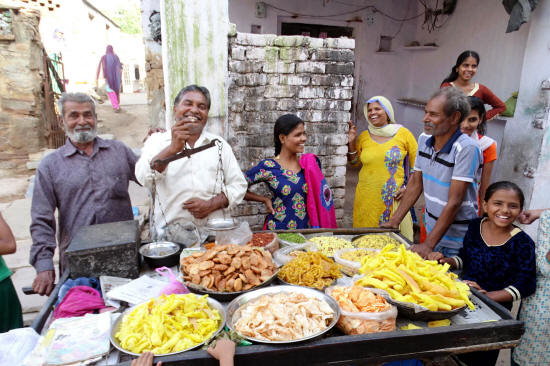
We saw no other westerners in a week and thus we
were treated with respect, humor and a bit of awe.
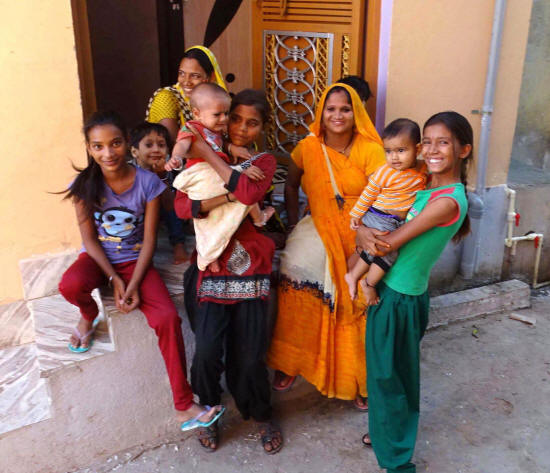
Not a word of English spoken during that time,
except by the Raj; we communicated with
the language of the heart.
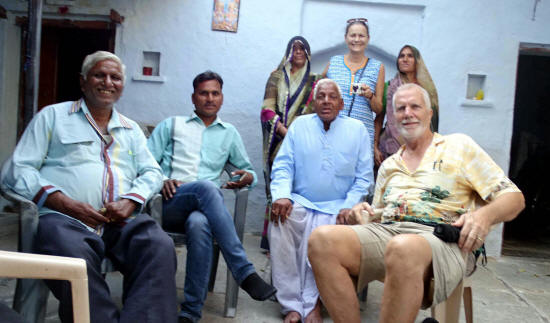
The people were genuinely warm, welcoming,
smiling and continually invited us into
their basic but clean little houses for chai.
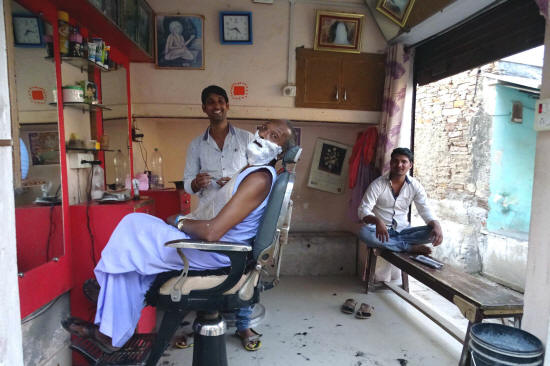
Shave and a haircut – 2 bits or 2 rupees.

Our friendly helper Moha.

The Chittor Fort or Chittorgarh is one of
the largest forts in India.

This nomadic band of gypsy’s was performing
outside our palace gates. The women were
really men skillfully dressed as women.
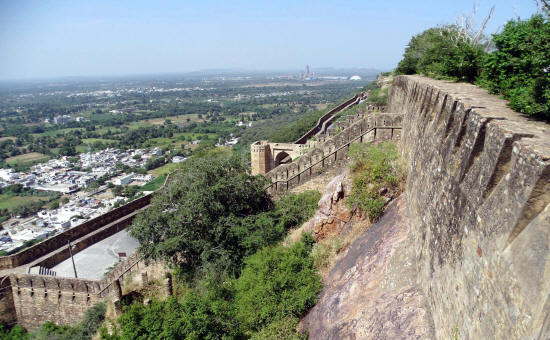
It is a UNESCO World Heritage Site.
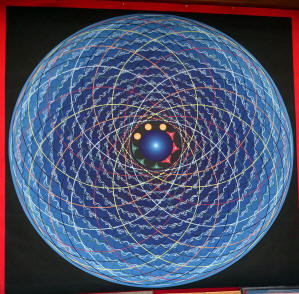
Back to Homepage
